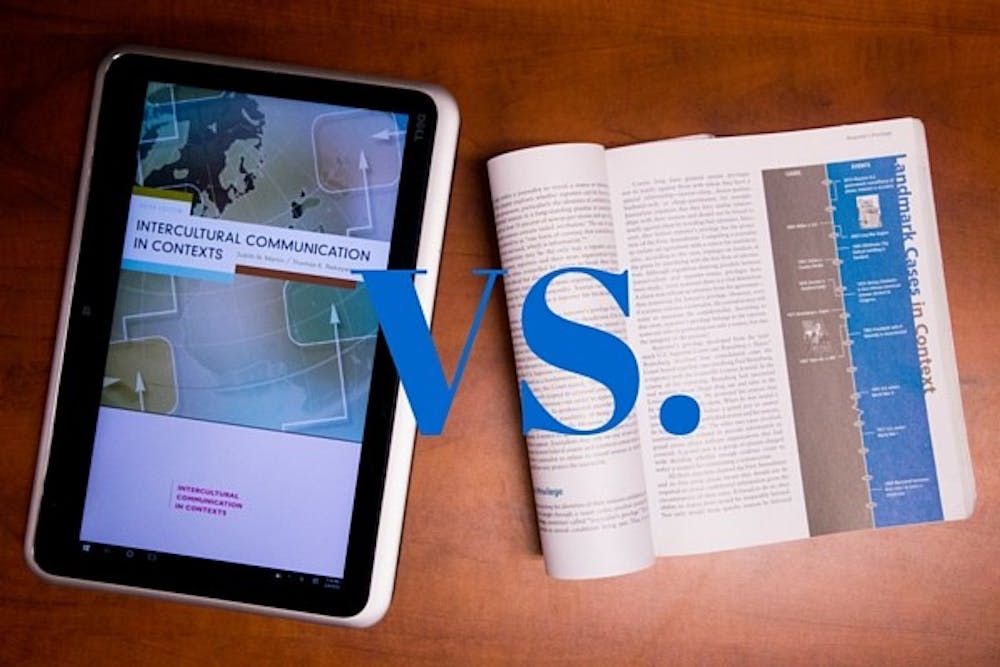We are three weeks into the spring semester and I, like most students, have shaken off the residual “cobwebs” of inactivity that tend to pop up during winter break. As the countdown for the first week back started, many of us received the dreadful (and expensive) required textbook list.
Looking back at my list of books, I realize that three of my five books were e-books and the two physical books could also be purchased digitally. As I began asking fellow students, I was surprised to see how many professors have began to use digital content in lieu of physical books.
The switch to digital learning formats has been propelled by continuous technological innovation as well as overpriced textbooks. According to a study by the American Enterprise Institute, the price of the average textbook has risen 812 percent since 1978, in comparison with the Consumer Price Index, which has risen 250 percent.
Many students may have had the same expectations I did when they went to the bookstore: to leave with a backpack 100 times heavier and with wallet a few hundred dollars lighter, but reality didn't meet my expectations. Instead of leaving the bookstore with a backpack full of textbooks, I left with a backpack full of access codes.
I don't support the use of e-books and similar technology-based education tools because I believe that they inhibit the learning process. A 2013 study published by USA Today showed that students aren’t able to retain the same amount of information after reading an e-book as as they would a physical copy.
An argument in support of e-books is that they allow students to engage directly with what they are learning. Owen Baldner, ASU journalism sophomore, says that digital tools are great for learning. “They tend to be more interactive, which can be helpful,” Baldner said. This interaction is a reason that schools like ASU have began collaborating with professors to integrate traditional curriculum into a more immersive digital setting.
Online learning is something that ASU President Michael Crow has been advocating in favor of for the past several years. He has secured over 150 technological partnerships with companies like Pearson, the largest academic publishing company in the world.
The hole I see in the current transition to digital education tools is that it allows students to more easily circumvent the learning process and do something that is usually less productive instead.
Julian Sario, an English literature student through ASU’s C.A.P partnership with Starbucks, knows that there are distractions involved with online learning.
“I find myself walking away from my laptop, and I’ll forget that I’m still supposed to be working,” Sario said.
Ryan Boyd, vice president of policy at Undergraduate Student Government Downtown, believes that although there has been inconsistency in successful adoption of digital education tools such as textbooks, there is a tremendous upside to online learning, including the prices.
“For some people, they really need the ability to physically highlight a page or make notes and hold the pages,” Boyd said. “But on the larger scale, it does expand learning in that it allows a lot of people who can't afford the textbook chapters ... to participate.”
As it turns out, price usually ends up being the most crucial determinant in the expansion of online books. Baldner, like Boyd, thinks that it helps students who are on a budget because e-books are generally cheaper than textbooks.
I believe that the possibility and likelihood of distraction is too high when it comes to online learning tools like textbooks. The upside to e-books is the low price and the user interaction that it enables, but it requires integration and education of the technology being used — integration that students like myself are not accustomed to. Until there is proper implementation and education of these digital learning tools, physical books are the best bet if students want to get the most out of their education.
Reach the columnist at @asu.edu or follow @steven_hdz20 on Twitter.
Editor’s note: The opinions presented in this column are the author’s and do not imply any endorsement from The State Press or its editors.
Want to join the conversation? Send an email to opiniondesk.statepress@gmail.com. Keep letters under 300 words and be sure to include your university affiliation. Anonymity will not be granted.
Like The State Press on Facebook and follow @statepress on Twitter.




